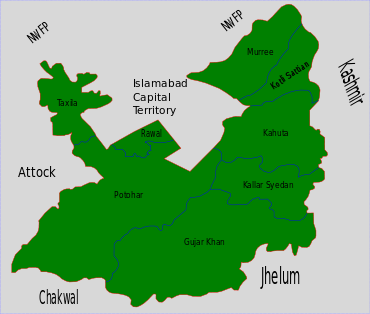Gujar Khan Tehsil
| Gujar Khan Tehsil | |
|---|---|
| Tehsil | |
 | |
| Country | Pakistan |
| Region | Punjab |
| District | Rawalpindi District |
| Capital | Gujar Khan |
| Union councils | 33 |
| Population (1998) | |
| • Total | 493,000 |
| Time zone | PST (UTC+5) |
| • Summer (DST) | PDT (UTC+6) |
Gujar Khan Tehsil, headquartered at Gujar Khan, is one of the seven Tehsils (sub-divisions) of Rawalpindi District in the Punjab province of Pakistan. It is administratively subdivided into 33 Union Councils[1] and according to the 1998 census has a population of 493,000.[2]
History
In 997 CE, Sultan Mahmud Ghaznavi, took over the Ghaznavid dynasty empire established by his father, Sultan Sebuktegin, In 1005 he conquered the Shahis in Kabul in 1005, and followed it by the conquests of Punjab region. The Delhi Sultanate and later Mughal Empire ruled the region. The Punjab region became predominantly Muslim due to missionary Sufi saints whose dargahs dot the landscape of Punjab region.
After the decline of the Mughal Empire, the Sikh Empire invaded and occupied Rawalpindi District. The Muslims faced restrictions during the Sikh rule. During the period of British rule, Gujar Khan Tehsil increased in population and importance.
The tehsil of Gujar Khan was described in the Imperial Gazetteer of India, compiled during the first decade of the twentieth century, as follows:[3]
"Southern tahsil of Rawalpindi District, Punjab, lying between 33°4′ and 33°26′ N. and 72°56′ and 73°37′ E., with an area of 567 square miles. It is bounded on the east by the Jhelum river, which cuts it off from Kashmir territory. Except for a low ridge of sandstone hills along the Jhelum, the tahsil consists of a plain intersected by numerous ravines. The population in 1901 was 150,566,compared with 152,455 in 1891. It contains 381 villages, of which Gujar Khan is the headquarters. The land revenue and cesses in 1903-4 amounted to 2-7 lakhs."
During the period of British rule, Gujar Khan Tehsil increased in population and importance. The predominantly Muslim population supported Muslim League and Pakistan Movement. After the independence of Pakistan in 1947, the minority Hindus and Sikhs migrated to India while the Muslims refugees from India settled down in the Rawalpindi District.
Administration
The tehsil of Gujar Khan is administratively subdivided into 33 Union Councils, these are: 1. Bewal - 2. Bhadana - 3. Changa Bangial - 4. Daultala - 5. Devi - 6. Gujar Khan-I - 7. Gujar Khan-II - 8. Gujar Khan-III - 9. Gulyana - 10. Gungrila - 11. Jand Mehlo - 12. Jarmot Kalan - 13. Jatli - 14. Jhungle - 15. Kalyam Awan - 16. Kaniat Khalil - 17. Karumb Ilyas - 18. Kauntrila - 19. Kuri Dolal - 20. Mandrah - 21. Manghot - 22. Mankiala Branmma - 23. Matwa - 24. Mohra Noori - 25. Narali - 26. Punjgran Kalan - 27. Qazian - 28. Raman - 29. Sahang - 30. Sui Cheemian - 31. Sukho - 32. Syed Kasran - 33. Thathi.34. Kuri Hazaro
Educational establishments include Punjab College, Govt. Sarwar Shaheed (N.H.) College, Indus College and the Super Wings Group of Colleges.
Sanghori
Sanghori Sarwar Shaheed is a village of Gujar Khan Tehsil, Rawalpindi District, in Punjab, Pakistan. Captain Sarwar Shaheed, the first Nishan-e-haider holder, was born in this village. A memorial to Captain Sarwar Shaheed (Nishan-E-haider) is situated in Sanghori Sarwar Shaheed. (Muhammad Zafran Malik)
Natural resources
Large reserves of oil and gas were discovered in February 2002 at Tobra, about ten kilometres from Gujar Khan. The field is being developed by the Oil and Gas Development Company. The field could produce 1,600 barrels of crude oil daily.[4]
See also
References
- ↑ Zila, Tehsil & Town Councils Membership for Punjab - Election Commission of Pakistan
- ↑ District Government of Rawalpindi
- ↑ Gujar Khān, v. 12, p. 353
- ↑ Asia Times Online (Holdings) Ltd. "Business in Asia". Retrieved 2007-07-02.
Coordinates: 33°24′20″N 73°14′40″E / 33.40556°N 73.24444°E
